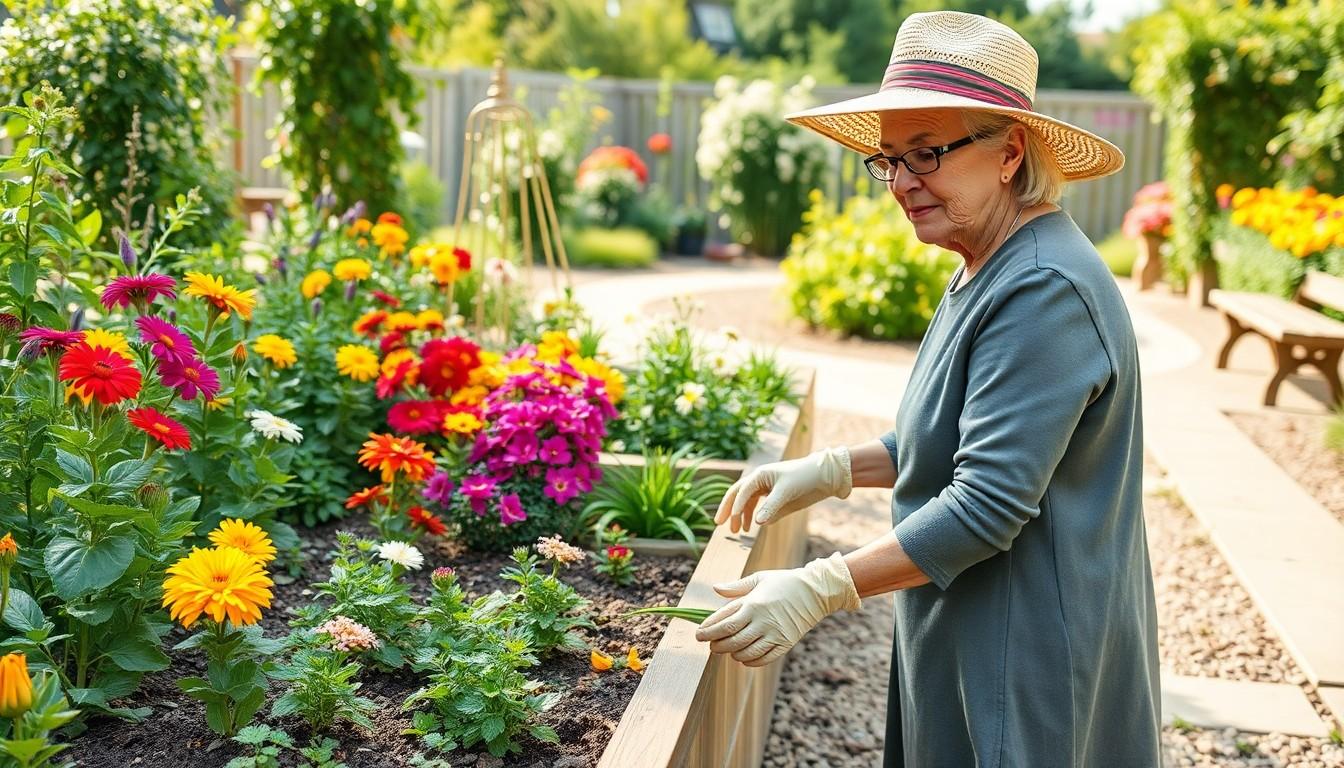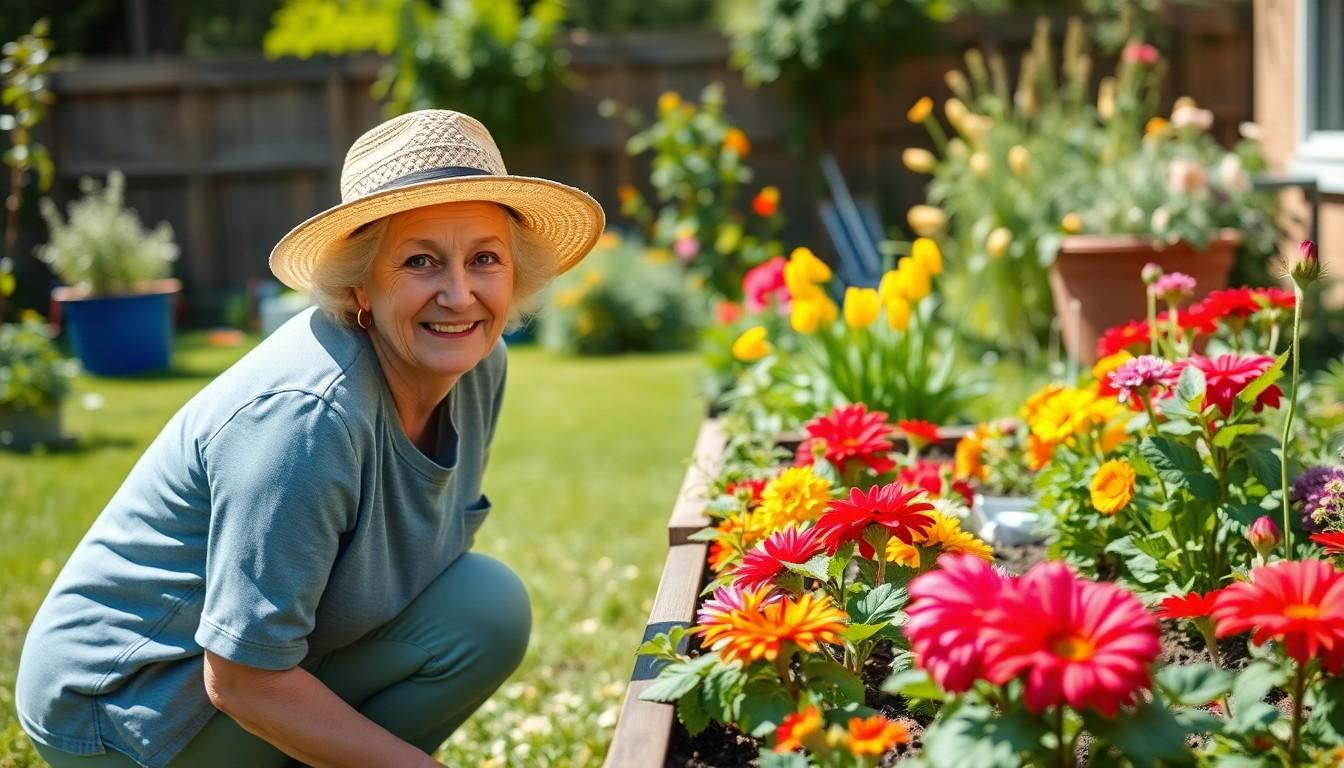Growing a garden brings joy at any age but it becomes even more rewarding during the golden years. For seniors looking to stay active and connected with nature gardening offers the perfect blend of gentle exercise mental stimulation and rewarding results.
As mobility and strength change with age traditional gardening methods might need some
creative adjustments. Today’s innovative gardening solutions make it easier than ever for older adults to continue nurturing their green thumbs without the strain of traditional methods. From raised beds to vertical gardens there’s a perfect solution for every senior gardener’s needs and abilities.
Gardening for Seniors
Regular gardening activities provide numerous health benefits for seniors while offering a rewarding outdoor experience. Studies demonstrate that engaging in gardening tasks enhances both physical function and cognitive abilities in older adults.
Physical Health Advantages
Gardening activities strengthen muscles through natural movements like digging planting weeding. Research from the Centers for Disease Control shows 30 minutes of gardening burns 150-300 calories improving cardiovascular health. The varied motions in gardening enhance flexibility balance coordination particularly in adults aged 65+. Regular garden maintenance activities increase bone density reducing osteoporosis risks according to the National Institutes of Health. Exposure to sunlight during outdoor gardening helps maintain healthy vitamin D levels essential for immune function bone health.
| Physical Benefit |
Impact on Seniors |
| Calorie Burn |
150-300/30 min |
| Activity Level |
Moderate-intensity |
| Weekly Exercise |
2.5-3 hours recommended |
| Muscle Groups |
Upper body lower body core |
Mental Wellbeing and Social Connection
Gardening creates opportunities for social interaction through community gardens garden clubs plant exchanges. Studies from the Journal of Health Psychology indicate gardening reduces cortisol levels lowering stress anxiety depression. Growing plants stimulates memory planning problem-solving skills helping maintain cognitive function. The sensory experience of working with plants soil creates mindful moments promoting relaxation focus. Community gardens foster friendships between neighbors creating support networks for older adults.
| Mental Health Benefit |
Success Rate |
| Stress Reduction |
75% improvement |
| Social Interaction |
68% increase |
| Cognitive Function |
50% enhancement |
| Depression Symptoms |
45% decrease |
Making Your Garden Senior-Friendly
Creating an age-friendly garden focuses on accessibility, safety, and comfort. These adaptations enable seniors to continue enjoying gardening while minimizing physical strain and potential hazards.
Accessible Garden Layout
Raised garden beds at 24-36 inches high eliminate the need for bending or kneeling while gardening. Wide, level pathways (minimum 36 inches) with non-slip surfaces accommodate wheelchairs and walking aids. Strategic placement of rest areas with sturdy benches every 20-30 feet provides convenient spots for breaks. Installing handrails along garden paths offers additional support and stability. Arranging plants in U-shaped or circular patterns reduces reaching distances and creates efficient work zones. Adding shade structures protects seniors from excessive sun exposure during peak gardening hours.
Ergonomic Tools and Equipment
Lightweight tools with extended handles reduce strain on joints and muscles during gardening tasks. Foam grip attachments increase tool diameter to 1.5-2 inches for easier gripping. Rolling garden seats combine mobility with comfort, featuring 360-degree rotation and tool storage compartments. Electric pruners minimize hand fatigue compared to manual alternatives. Garden tool organizers mounted at waist height keep equipment accessible without bending. Telescoping water wands extend reach by 3-6 feet for effortless plant watering. Self-coiling garden hoses prevent tripping hazards and reduce storage space requirements.
Container and Raised Bed Gardening
Container and raised bed gardening enables seniors to maintain their gardening hobby with reduced physical strain. These elevated growing spaces create an accessible environment that minimizes bending and kneeling while maximizing growing potential.
Easy-to-Manage Plant Options
Compact vegetables like cherry tomatoes, lettuce varieties, bush beans, radishes, herbs and dwarf peppers thrive in containers. Slow-growing succulents require minimal maintenance while providing year-round visual interest. Container-friendly flowers include marigolds, zinnias, petunias and geraniums that produce abundant blooms without extensive care. Mediterranean herbs such as rosemary, thyme and sage adapt well to container environments with limited watering needs. Dwarf fruit trees like citrus, figs and kumquats grow successfully in large containers while providing accessible harvests.
Space-Saving Garden Solutions
Vertical gardening systems maximize growing space by utilizing wall-mounted planters, trellises and hanging baskets. Stackable containers create multi-level gardens that accommodate numerous plants in a small footprint. Window boxes attached at comfortable heights bring plants within easy reach while brightening exterior spaces. Tiered raised beds with built-in seating edges provide comfortable access to multiple planting areas. Rolling plant stands allow containers to be moved easily between sun and shade locations or brought indoors during extreme weather. Self-watering containers reduce maintenance demands through water reservoirs that provide consistent moisture levels.
Safety Tips for Senior Gardeners
Senior gardening safety combines protective measures with smart scheduling to prevent injuries while maintaining an enjoyable experience. The following guidelines protect older adults during gardening activities.
Preventing Common Injuries
-
- Wear knee pads or cushioned mats when working at ground level
-
- Use ergonomic tools with non-slip grips to reduce joint strain
-
- Protect hands with properly fitted gardening gloves to prevent cuts
-
- Stay hydrated by keeping water within easy reach
-
- Apply sunscreen rated SPF 30+ to exposed skin
-
- Wear a wide-brimmed hat to shield face neck from sun exposure
-
- Choose loose-fitting breathable clothing with long sleeves
-
- Keep paths clear of tools hoses or debris
-
- Install handrails near steps garden beds or slopes
-
- Use wheeled carts instead of carrying heavy loads
-
- Take frequent breaks to prevent muscle fatigue or overexertion
Best Times for Garden Activities
-
- Morning hours between 7-10 AM offer ideal temperatures lower humidity
-
- Late afternoon gardening from 4-6 PM avoids peak sun exposure
-
- Cloudy days provide extended comfortable working conditions
-
- 15-minute activity intervals prevent physical strain
-
- Rest periods every 30 minutes maintain energy levels
-
- Indoor gardening tasks fill midday hours from 11 AM-3 PM
-
- Spring fall seasons allow longer outdoor working periods
-
- Winter months focus on indoor plant maintenance planning
-
- Temperature ranges between 60-75°F create optimal conditions
-
- Light rain-free days reduce slipping hazards
Low-Maintenance Plants for Senior Gardens
Low-maintenance plants reduce physical demands while providing enjoyable gardening experiences for seniors. These plants thrive with minimal care requirements offering beautiful blooms seasonal interest.
Perennials and Native Species
Native perennials create sustainable gardens that return year after year without replanting. Black-eyed Susans attract pollinators with bright yellow blooms from June through September. Coneflowers provide sturdy stems reaching 24-36 inches tall featuring pink purple petals. Butterfly weed produces vibrant orange clusters supporting local butterfly populations. These plants establish deep root systems requiring less frequent watering once mature. Native ornamental grasses like switchgrass offer movement texture with virtually no maintenance beyond annual trimming.
Drought resistant plants conserve water while thriving in challenging conditions. Lavender grows 18-24 inches tall producing fragrant purple spikes that bloom throughout summer. Sedum varieties form dense mats of succulent foliage topped with long lasting flower clusters. Russian sage reaches 3-5 feet with delicate silver foliage aromatic purple flowers. These plants tolerate poor soil conditions sustaining growth during dry spells. Mediterranean herbs including rosemary thyme sage combine drought tolerance with culinary benefits maintaining compact shapes with minimal pruning.
Adaptive Gardening Techniques
Adaptive gardening techniques transform traditional gardening methods into accessible activities for seniors. These modifications incorporate specialized tools with ergonomic features alongside strategic approaches to minimize physical strain.
Modified Tools and Methods
Modified gardening tools feature ergonomic designs that reduce joint stress during use. Long-handled tools extend reach by 12-24 inches enabling seniors to work from a standing position. Foam grip attachments increase tool handle diameter to 1.5 inches improving control for arthritic hands. Rolling garden seats with 360-degree rotation eliminate repeated standing movements. Garden tool organizers mounted at waist height keep implements within easy reach. Automatic watering systems with timers reduce the need to carry heavy watering cans.
Comfortable Working Positions
Vertical gardening stations position plants at eye level reducing neck strain. Garden kneelers with handles support 300 pounds during transitions between sitting standing positions. Telescoping tools adjust to individual height requirements ranging from 25-45 inches. Raised beds at 36 inches accommodate wheelchair access from all sides. Garden stools with adjustable heights from 18-24 inches enable seated work at various levels. Rolling carts transport supplies weighing up to 50 pounds without lifting.
Drought-Resistant Options
Gardening remains a fulfilling and accessible hobby for seniors with the right adaptations and approaches. Through thoughtful garden design ergonomic tools and senior-friendly planting strategies older adults can continue nurturing their green thumbs while maintaining safety and comfort.
The physical and mental health benefits combined with opportunities for social connection make gardening an invaluable activity for seniors. By implementing the suggested modifications and focusing on low-maintenance plants seniors can create beautiful sustainable gardens that bring joy for years to come.
With proper planning and the right tools gardening can evolve alongside seniors’ changing needs while continuing to enrich their lives through nature’s endless rewards.


